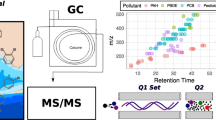Abstract
The aim of this work is the highly sensitive determination of 117 contaminants in surface waters at very low concentrations. Gas chromatography-amenable priority compounds from the European Water Framework Directive (EWFD, 45 priority substances) and substances from the Turkish Regulation on the Management of Surface Water Quality (TRMSWQ, 250 substances) were analyzed. Almost a third to one half of the compounds in the TRMSWQ list were successfully detected in a single gas chromatography-tandem mass spectrometry (GC-MS/MS) injection. Analyzing these pollutants in water samples is difficult with conventional extraction methods. An efficient, easy and fast method for both extraction and analysis is thus important. Here, the stir bar sorptive extraction (SBSE) approach employing Twister® was used for analyte enrichment from 100 mL water samples. The Twister apparatus was used for thermal desorption. Compounds were separated via gas chromatography (GC) and detected by tandem mass spectrometry (MS/MS) utilizing an Agilent 7000D MS instrument. The analysis method was comprehensively validated, and complied with the requirements of the EWFD and Turkish regulation for surface water quality for inland surface water. The method includes various endocrine disruptor compounds listed in the EWFD, such as polychlorinated biphenyls, polycyclic aromatics hydrocarbons, polybrominated diphenyl ethers, phenols, phthalates and pesticides. The method is also applicable for the analysis of similar contaminants that are not on this list. The analyzed pollutants have varying polarities based on octanol–water coefficients and are extracted by SBSE. This method may be preferred for the analysis of pollutants with an octanol–water partition coefficient (log Ko/w) higher than 2. The SBSE method, which is easy, lab-friendly and quick, taking a total of only 2 h for parameter analysis, was optimized to reduce time and chemical usage. The entire extraction and analysis was completed in virtually 3 h. The limits of quantification (LOQs) ranged from 0.12 to 50 ng/L and complied with the requirements for analytical methods to be used in the analysis of the compounds included in the directives. Several quality parameters including linearity, trueness and precision were studied, with good results, and uncertainty was also estimated. Precision (in terms of relative standard deviation [RSD]) was lower than 40%, recoveries ranged from 60 to 120%, and determination coefficients were higher than 0.990 for all analytes.

Graphical abstract

Similar content being viewed by others
References
Council Directive 2000/60/EC of the European Parliament and of the council of 23 October 2000 on establishing a framework for Community action in the field of water policy.
Council Directive 2006/118/EC of the European Parliament and of the council of 12 December 2006 on the protection of groundwater against pollution and deterioration.
Council Directive 2008/105/EC of the European Parliament and of the council of 16 December 2008 on environmental quality standards in the field of water policy.
Council Directive 2013/39/EU of the European Parliament and of the council of 12 August 2013 on amending Directives 2000/60/EC and 2008/105/EC as regards priority substances in the field of water policy.
Baltussen E, Sandra P, David F, Janssen HG, Cramer C. Study into the equilibrium mechanism between water and poly(dimethylsiloxane) for very apolar solutes : adsorption or sorption ? Anal Chem. 1999;71:5213–6.
Baltussen E, Cramers CA, Sandra PJF. Sorptive sample preparation – a review. Anal Bioanal Chem. 2002;373:3–22.
David F, Sandra P. Stir bar sorptive extraction for trace analysis. J Chromatogr A. 2007;1152:54–69.
Kawaguchi M, Ito R, Saito K, Nakazawa H. Novel stir bar sorptive extraction methods for environmental and biomedical analysis. J Pharm Biomed Anal. 2006;40:500–8.
Lancas FM, Queiroz MEC, Grossi P, Olivares IRB. Recent developments and applications of stir bar sorptive extraction. J Sep Sci. 2009;32:813–24.
Prieto A, Basauri O, Rodil R, Usobiaga A, Fernandez LA, Etxebarria N, et al. Stir-bar sorptive extraction: a view on method optimisation, novel applications, limitations and potential solutions. J Chromatogr A. 2010;1217:2642–66.
Laaks J, Jochmann MA, Schmidt TC. Solvent-free microextraction techniques in gas chromatography. Anal Bioanal Chem. 2012;402:565–71.
Camino-Sánchez FJ, Rodriquez-Gomez R, Zafra-Gomez A, Santos-Fandilla A, Vilchez JL. Stir bar sorptive extraction: recent applications, limitations and future trends. Talanta. 2014;130:388–99.
Nogueira JMF. Stir-bar sorptive extraction: 15 years making sample preparation more environment-friendly. Trends Anal Chem. 2015;71:214–23.
European Commission Decision 2002/657/EC of 12 August 2002 implementing Council Directive 96/23/EC, concerning the performance of analytical methods and interpretation of the results, Official Journal of the European Communities International. 2002; L221: 8–36.
Llorca-Porcel J, Martinez-Sanchez G, Alvarez B, Cobollo MA, Valor I. Analysis of nine polybrominated diphenyl ethers in water samples by means of stir bar sorptive extraction-thermal desorption-gas chromatography–mass spectrometry. Anal Chim Acta. 2006;569:113–8.
Chary NS, Herrera S, Gomez MJ, Fernandez-Alba AR. Parts per trillion level determination of endocrine-disrupting chlorinated compounds in river water and wastewater effluent by stir-bar-sorptive extraction followed by gas chromatography – triple quadrupole mass spectrometry. Anal Bioanal Chem. 2012;404:1993–2006.
Serôdio P, Cabral SM, Nogueira JMF. Use of experimental design in the optimization of stir bar sorptive extraction for the determination of polybrominated diphenyl ethers in environmental matrices. J Chromatogr A. 2007;1141:259–70.
Serodio P, Nogueira JMF. Development of a stir-bar-sorptive extraction–liquid desorption–large-volume injection capillary gas chromatographic–mass spectrometric method for pyrethroid pesticides in water samples. Anal Bioanal Chem. 2005;382:1141–51.
Ochiai N, Sasamato K, Kanda H, Pfannkoch E. Sequential stir bar sorptive extraction for uniform enrichment of trace amounts of organic pollutants in water samples. J Chromatogr A. 2008;1200:72–9.
Tölgyessy P, Vrana B, Krascsenits Z. Development of a screening method for the analysis of organic pollutants in water using dual stir bar sorptive extraction-thermal desorption-gas chromatography–mass spectrometry. Talanta. 2011;87:152–60.
León VM, Llorca-Porcel J, Alvarez B, Cobollo MA, Munoz S, Valor I. Analysis of 35 priority semivolatile compounds in water by stir bar sorptive extraction–thermal desorption–gas chromatography–mass spectrometry: I. Method optimisation. J Chromatogr A. 2003;999:91–101.
Camino-Sánchez FJ, Zafra-Gomez A, Cantarero-Malagon S, Vilchez JL. Validation of a method for the analysis of 77 priority persistent organic pollutants in river water by stir bar sorptive extraction in compliance with the European water framework directive. Talanta. 2012;89:322–34.
Camino-Sánchez FJ, Zafra-Gomez A, Ruiz-Garcia J, Vilchez JL. Screening and quantification of 65 organic pollutants in drinking water by stir bar sorptive extraction-gas chromatography-triple quadrupole mass spectrometry. Food Anal Methods. 2013;6:854–67.
Magnusson B, Ornemark U. Eurachem guide: the fitness for purpose of € analytical methods e a laboratory guide to method validation and related topics, 2nd ed.; 2014.
AOAC. Appendix F: guidelines for standard methods performance requirements in: AOAC official methods of analysis; 2016.
Acknowledgements
The authors are thankful to Mr. Ensar Ay and Mr. Hüseyin Demir for their laboratory work support.
Author information
Authors and Affiliations
Corresponding author
Ethics declarations
Conflict of interest
The authors declare that they have no conflict of interest.
Additional information
Published in the topical collection Euroanalysis XX with guest editor Sibel A. Ozkan.
Publisher’s note
Springer Nature remains neutral with regard to jurisdictional claims in published maps and institutional affiliations.
Rights and permissions
About this article
Cite this article
Canlı, O., Çetintürk, K. & Öktem Olgun, E.E. Determination of 117 endocrine disruptors (EDCs) in water using SBSE TD–GC-MS/MS under the European Water Framework Directive. Anal Bioanal Chem 412, 5169–5178 (2020). https://doi.org/10.1007/s00216-020-02553-4
Received:
Revised:
Accepted:
Published:
Issue Date:
DOI: https://doi.org/10.1007/s00216-020-02553-4




